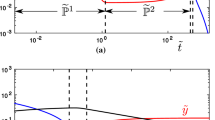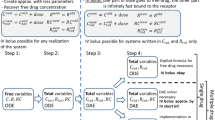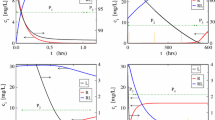Abstract
The aim of this work is to study global dynamics of target-mediated drug disposition (TMDD) models and their solutions by nonstandard finite difference (NSFD) schemes. Firstly, we use comparison principles and the Lyapunov stability theory for ODEs to establish positivity, boundedness, local and global asymptotic stability of the TMDD models. Secondly, positivity-preserving NSFD schemes are proposed and their dynamical properties are analysed rigorously. Lastly, we perform a set of numerical simulations to support and illustrate the theoretical results and to show advantages of the NSFD schemes over standard ones. The results show that there is a good agreement between the numerical results and theoretical ones. In addition, the numerical simulations indicate that the constructed NSFD schemes are dynamically stable and efficient in replicating the complex dynamical properties of the continuous models.








Similar content being viewed by others
References
Adekanye, O., Washington, T.: Nonstandard finite difference scheme for a Tacoma narrows bridge model. Appl. Math. Modell. 62, 223–236 (2018)
Allen, J.L.S.: Introduction to Mathematical Biology. Pearson Education, Inc, Upper Saddle River (2007)
Anguelov, R., Lubuma, J.M.-S.: Nonstandard finite difference method by nonlocal approximations. Math. Comput. Simul. 61, 465–475 (2003)
Anguelov, R., Dumont, Y., Lubuma, J.M.-S., Shillor, M.: Dynamically consistent nonstandard finite difference schemes for epidemiological models. J. Comput. Appl. Math. 255, 161–182 (2014)
Arenas, A.J., González-Parra, G., Chen-Charpentier, B.M.: A nonstandard numerical scheme of predictor corrector type for epidemic models. Comput. Math. Appl. 59, 3740–3749 (2010)
Aston, P.J., Derks, G., Raji, A., Agoram, B.M., van der Graaf, P.H.: Mathematical analysis of the pharmacokinetic-pharmacodynamic (PKPD) behaviour of monoclonal antibodies: predicting in vivo potency. J. Theor. Biol. 281, 113–121 (2011)
Burden, R.L., Faires, J.D.: Numerical Analysis, 9th edn. Brooks/Cole, Cengage Learning, San Francisco
Chapwanya, M., Lubuma, J.M.S., Mickens, R.E.: From enzyme kinetics to epidemiological models with Michaelis–Menten contact rate: design of nonstandard finite difference schemes. Comput. Math. Appl. 64, 201–213 (2012)
Dang, Q.A., Hoang, M.T.: Dynamically consistent discrete metapopulation model. J. Differ. Equ. Appl. 22, 1325–1349 (2016)
Dang, Q.A., Hoang, M.T.: Lyapunov direct method for investigating stability of nonstandard finite difference schemes for metapopulation models. J. Differ. Equ. Appl. 24, 15–47 (2018)
Dang, Q.A., Hoang, M.T.: Complete global stability of a metapopulation model and its dynamically consistent discrete models. Qual. Theory Dyn. Syst. 18, 461–475 (2019)
Dang, Q.A., Hoang, M.T.: Nonstandard finite difference schemes for a general predator–prey system. J. Comput. Sci. 36, 101015 (2019)
Dang, Q.A., Hoang, M.T.: Exact finite difference schemes for three-dimensional linear systems with constant coefficients. Vietnam J. Math. 46, 471–492 (2018)
Dang, Q.A., Hoang, M.T., Dang, Q.L.: Nonstandard finite difference schemes for solving a modified epidemiological model for computer viruses. J. Comput. Sci. Cybern. 34, 171–185 (2018)
Dang, Q.A., Hoang, M.T.: Positive and elementary stable explicit nonstandard Runge–Kutta methods for a class of autonomous dynamical systems. Int. J. Comput. Math. 97, 2036–2054 (2020). https://doi.org/10.1080/00207160.2019.1677895
Dang, Q.A., Hoang, M.T.: Positivity and global stability preserving NSFD schemes for a mixing propagation model of computer viruses. J. Comput. Appl. Math. 374, 112753 (2020)
Dua, P., Hwakins, E., van der Graaf, P.H.: A tutorial on target-mediated drug disposition (TMDD) models. CPT Pharmacometrics Syst. Pharmacol. 4, 324–337 (2015)
Egbelowo, O.F.: Nonstandard finite difference approach for solving 3-compartment pharmacokinetic models. Int. J. Numer. Methods Biomed. Eng. 34, e3114 (2018). https://doi.org/10.1002/cnm.3114
Egbelowo, O.: Nonlinear elimination of drugs in one-compartment pharmacokinetic models: nonstandard finite difference approach for various routes of administration. Math. Comput. Appl. 23, 27 (2018)
Egbelowo, O.F.: The nonstandard finite difference method applied to pharmacokinetic models. PhD Thesis, University of the Witwatersrand, Johannesburg, South Africa (2018)
Egbelowo, O., Harley, C., Jacobs, B.: Nonstandard finite difference method applied to a linear pharmacokinetics model. Bioengineering 4, 40 (2017)
Estep, D.: A posteriori error bounds and global error control for approximation of ordinary differential equations. SIAM J. Numer. Anal. 32, 1–48 (1995)
González-Parra, G., Arenas, A.J., Chen-Charpentier, B.M.: Combination of nonstandard schemes and Richardson’s extrapolation to improve the numerical solution of population models. Math. Comput. Model. 52, 1030–1036 (2010)
Hoang, M.T., Egbelowo, O.F.: Nonstandard finite difference schemes for solving an SIS epidemic model with standard incidence. Rend. Circolo Mat. Palermo Ser. 69, 753–769 (2019). https://doi.org/10.1007/s12215-019-00436-x
Hoang, M.T., Egbelowo, O.F.: On the global asymptotic stability of a hepatitis B epidemic model and its solutions by nonstandard numerical schemes. Boletín de la Sociedad Matemáitica Mexicana 26, 1113–1134 (2020). https://doi.org/10.1007/s40590-020-00275-2
Hoang, M.T., Nagy, A.M.: Uniform asymptotic stability of a logistic model with feedback control of fractional order and nonstandard finite difference schemes. Chaos Solitons Fractals 123, 24–34 (2019)
Hoang, M.T., Egbelowo, O.F.: Numerical dynamics of nonstandard finite difference schemes for a Logistics model with feedback control. Ann. Univ. Ferrara 66, 51–65 (2020). https://doi.org/10.1007/s11565-020-00338-2
Holm, B., Wihler, T.P.: Continuous and discontinuous Galerkin time stepping methods for nonlinear initial value problems with application to finite time blow-up. Numer. Math. 138(3), 767–799 (2018)
Hulme, B.L.: One-step piecewise polynomial Galerkin methods for initial value problems. Math. Comput. 26, 415–426 (1972)
Khalil, H.K.: Nonlinear Systems, 3rd edn. Prentice Hall, Upper Saddle River (2002)
Korpusik, A.: A nonstandard finite difference scheme for a basic model of cellular immune response to viral infection. Commun. Nonlinear Sci. Numer. Simul. 43, 369–384 (2017)
Levy, G.: General pharmacologic target-mediated drug disposition. Clin. Pharmacol. Ther. 56, 248–252 (1994)
Mager, D.E., Jusko, W.J.: General pharmacokinetic model for drugs exhibiting target-mediated drug disposition. J. Pharmacokinet. Pharmacodyn. 28(6), 507–532 (2001)
Mickens, R.E.: Nonstandard finite difference schemes for differential equations. J. Diff. Equ. Appl. 8, 823–847 (2002)
Mickens, R.E.: Applications of Nonstandard Finite Difference Schemes. World Scientific, Singapore (2000)
Mickens, R.E.: Advances in the Applications of Nonstandard Finite Difference Schemes. World Scientific, Singapore (2005)
Mickens, R.E.: Nonstandard Finite Difference Models of Differential Equations. World Scientific, Singapore (1993)
Peletier, L.A., Gabrielsson, J.: Dynamics of target-mediated drug disposition: characteristic profiles and parameter identification. J. Pharmacokinet. Pharmacodyn. 39, 429 (2012). https://doi.org/10.1007/s10928-012-9260-6
Smith, H.L., Waltman, P.: The Theory of the Chemostat: Dynamics of Microbial Competition. Cambridge University Press, Cambridge (1995)
Wihler, T.P.: An a priori error analysis of the hp-version of the continuous Galerkin FEM for nonlinear initial value problems. J. Sci. Comput. 25(3), 523–549 (2005)
Wood, D.T., Kojouharov, H.V.: A class of nonstandard numerical methods for autonomous dynamical systems. Appl. Math. Lett. 50, 78–82 (2016)
Acknowledgements
The authors thank the editors and anonymous referees for useful and valuable comments that led to a great improvement of the paper. Oluwaseun Egbelowo is particularly grateful to Charis Harley (University of Johannesburg) and Byron Jacobs (University of Johannesburg) for the useful discussion that led to this paper. The second author, Manh Tuan Hoang, is supported by Institute of Information Technology, Vietnam Academy of Science and Technology under the Grant Number CS 20.01.
Author information
Authors and Affiliations
Corresponding author
Ethics declarations
Conflict of interest
The authors have no conflict of interest.
Author contributions
All authors contributed equally to the manuscript. All authors read and approved the final version of the manuscript.
Additional information
Publisher's Note
Springer Nature remains neutral with regard to jurisdictional claims in published maps and institutional affiliations.
Appendix A: Convergence of the NSFD schemes
Appendix A: Convergence of the NSFD schemes
The following results on the convergence of the NSFD schemes are proved similarly to Theorem 5.9 in [7].
Proposition 1
The NSFD scheme (11) for the model (1) is convergent of order 1.
Proof
We rewrite the model (1) in the vector form
where \(y(t) = \big [L(t), R(t), P(t)\big ]^T\) and f denotes the right-hand side function of (1). It is easy to verify that (11) can be written in the form
where
Using the hypothesis \(\varphi (h) = h + \mathcal {O}(h^2)\) as \(h \rightarrow 0\) and (25) and repeating the proof of [7, Theorem 5.9], we obtain
for \(i = 0, 1, 2, \ldots \). Consequently, the proof is complete. \(\square \)
Similarly to Proposition 1, we obtain the convergence of the NSFD (20) as follows.
Proposition 2
The NSFD scheme (20) for the model (6) is convergent of order 1.
Rights and permissions
About this article
Cite this article
Egbelowo, O.F., Hoang, M.T. Global dynamics of target-mediated drug disposition models and their solutions by nonstandard finite difference method. J. Appl. Math. Comput. 66, 621–643 (2021). https://doi.org/10.1007/s12190-020-01452-2
Received:
Revised:
Accepted:
Published:
Issue Date:
DOI: https://doi.org/10.1007/s12190-020-01452-2




